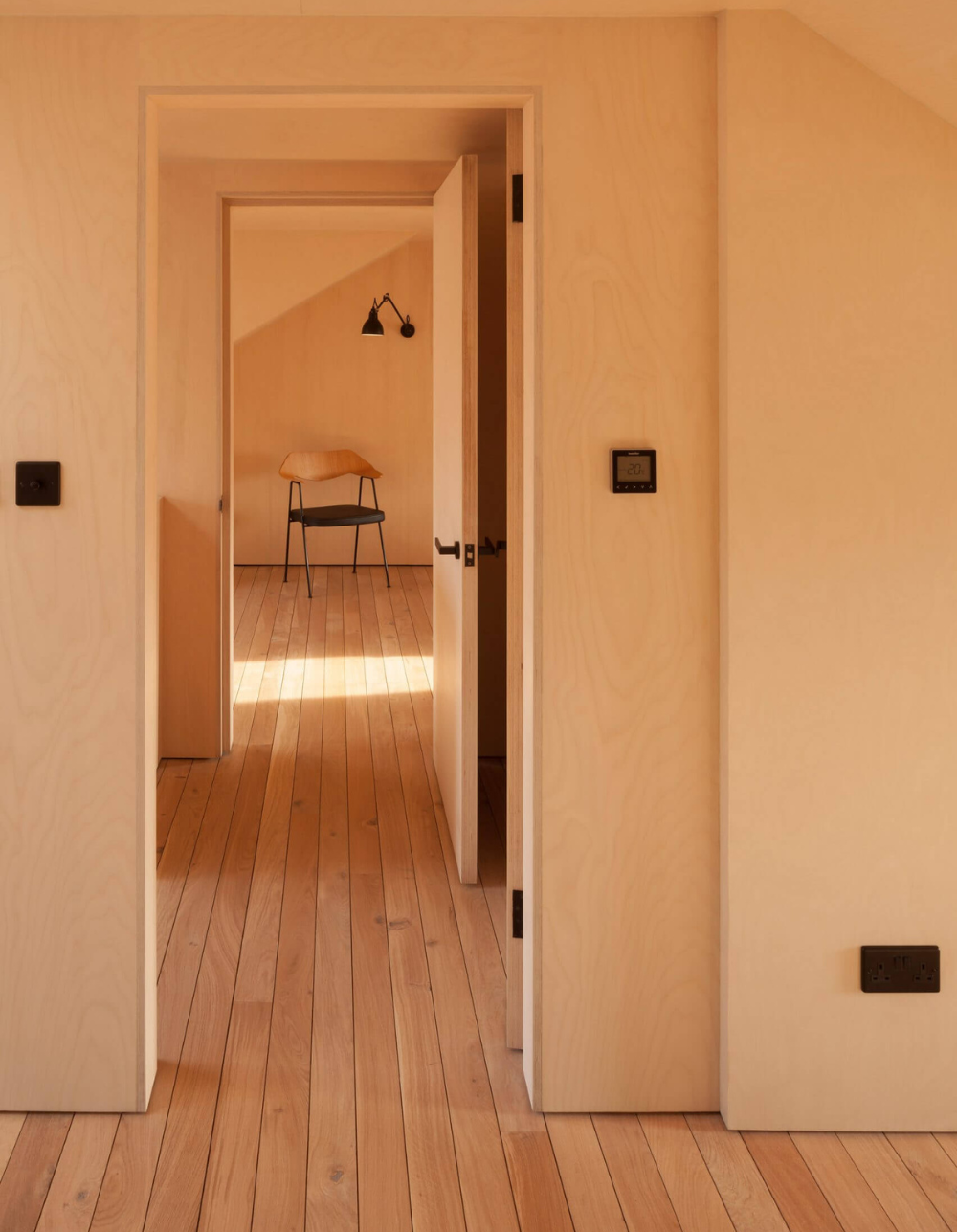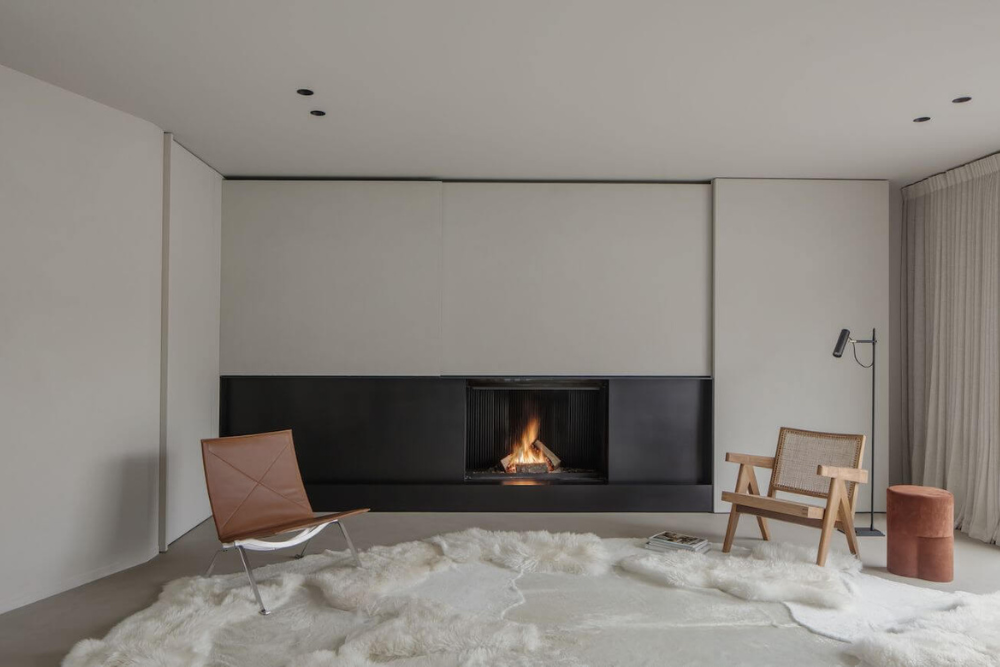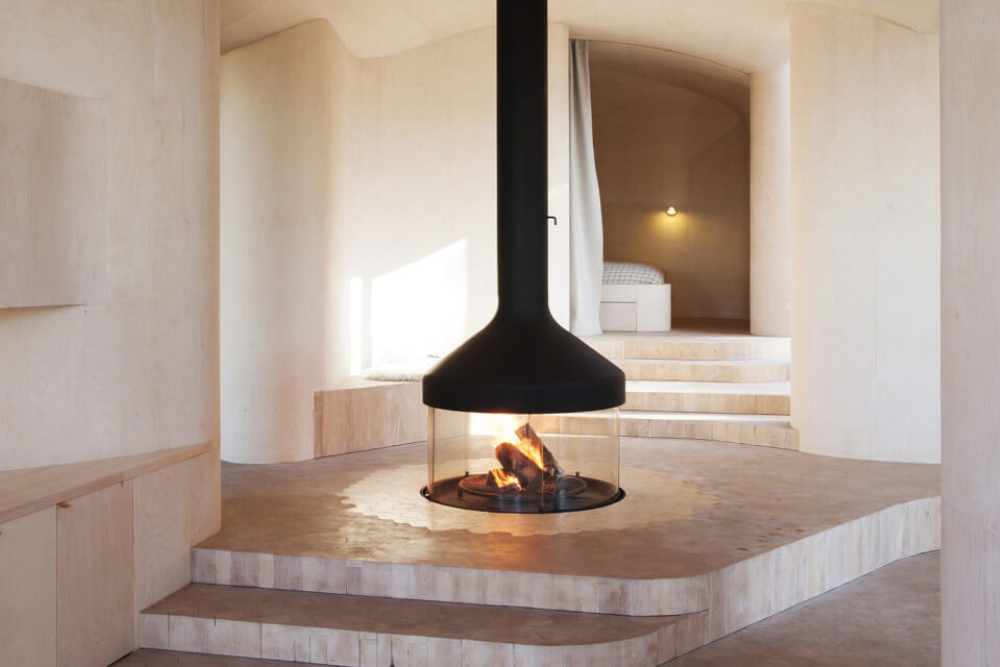23 Aesthetic Bedroom Ideas For A Cosy And Stylish Space
In this post, I'll be sharing some of my favourite aesthetic bedroom ideas to help you transform your bedroom into the cosy, stylish sanctuary you deserve.
If you're like me, your bedroom is your sanctuary. It's where you retreat to at the end of a long day to relax, unwind, and recharge. But have you ever looked around your bedroom and felt like something was missing? Perhaps it feels dull or uninspired, lacking in personality and character. That's where aesthetic bedroom ideas come in.
Dumbo Loft by Crystal Sinclair Designs. Photography by Seth Caplan.
Aesthetic bedroom design is all about creating a space that not only looks beautiful but also feels welcoming and cosy. It's about finding the perfect balance between form and function and creating a space that truly reflects your personality and style.
As someone who has always been passionate about interior design, I believe that your bedroom should be a reflection of who you are. It's the one room in your home where you can truly express yourself and let your personality shine through. Whether you're into minimalist decor or bold, eclectic designs, there's an aesthetic bedroom style out there for everyone.
So in this post, I'll be sharing my top tips and ideas for creating an aesthetic bedroom that you'll love spending time in. Whether you're starting from scratch or simply looking to refresh your existing decor, these tips are sure to inspire you and help you create a space that's truly your own. From choosing the right colour scheme to selecting the perfect decor and accessories, I'll cover everything you need to know to create a space that's both aesthetically beautiful and functional.
Battersea House by Proctor & Shaw. Photography by Stale Eriksen.
Importance of Aesthetic Bedroom Ideas
But first, let's talk about why aesthetic bedroom ideas are so important. After all, your bedroom is the one room in your home where you spend the most time, so it's important that it feels comfortable and inviting. Aesthetics play a big role in how we perceive our surroundings, and a well-designed bedroom can have a huge impact on our mood and well-being.
Aesthetic bedroom ideas are also important because they allow us to express ourselves and our personalities. Your bedroom should be a space that reflects your unique tastes and interests, whether that means incorporating bold colours and patterns or keeping things minimal and serene.
The Palace Gate Apartment by Tala Fustok Studio. Photography by Michael Sinclair.
Finally, aesthetic bedroom design is important because it can help us to relax and unwind. Your bedroom should be a place where you can escape from the stresses of daily life and feel at peace. By creating a space that's both beautiful and functional, you can create a bedroom that's the ultimate relaxation destination.
“An aesthetic bedroom is a well-designed and visually appealing sleeping space that reflects the personality and style of its owner. It is a place of comfort, relaxation, and personal expression.”
Hygge Studio by Melina Romano. Photography by MCA Estúdio.
Aesthetic Bedroom Ideas
Aesthetic Bedroom Styles
Many different interior design styles can be used to create an aesthetically pleasing bedroom. Each style has its unique characteristics, colour schemes, and decorative elements.
Minimalist
Minimalist style is characterised by simplicity, functionality, and a focus on clean lines and neutral colours. It emphasises the use of natural light and space to create an open and uncluttered feel.
Bohemian
Bohemian style is characterised by a mix of colours, patterns, and textures, often with a focus on natural materials and handmade items. It creates a relaxed and eclectic atmosphere that encourages self-expression.
Scandinavian
The Scandinavian style is characterised by simplicity, functionality, and a focus on light colours and natural materials. It emphasises clean lines and a minimalist approach to furniture and decor.
Mid-Century Modern
Mid-century modern style is characterised by bold colours, clean lines, and a mix of organic and geometric shapes. It often features retro-inspired furniture and decor, as well as pops of bright colour.
Industrial
Industrial style is characterised by the use of raw, unfinished materials such as metal and concrete, often with a focus on salvaged or repurposed items. It creates a rustic, edgy atmosphere that emphasizes function over form.
To choose the right aesthetic interior design style for your bedroom, consider your style, the mood you want to create, and the practical needs of the space.
Colonia Condesa House by Chloé Mason Gray. Photography by Fabian Martinez.
Colour Psychology in Aesthetic bedrooms
Colour psychology is the study of how colours can affect mood, behaviour, and emotions. It is an important consideration in interior design, as colours can have a significant impact on the overall atmosphere of a room.
Popular Colours and Their Meanings
Red
Red is a bold and powerful colour that is associated with passion, energy, and excitement. It can also create a sense of warmth and comfort.
Blue
Blue is a calming and soothing colour that is associated with peace, tranquillity, and relaxation. It can also create a sense of serenity and stability.
Green
Green is a refreshing and rejuvenating colour that is associated with nature, growth, and renewal. It can also create a sense of balance and harmony.
Yellow
Yellow is a cheerful and optimistic colour that is associated with happiness, energy, and warmth. It can also create a sense of creativity and playfulness.
Purple
Purple is a mysterious and intriguing colour that is associated with luxury, creativity, and spirituality. It can also create a sense of sophistication and elegance.
Condominio Monti by Studio Tamat and Sabina Guidotti. Photography by Serena Eller Vainicher.
How to Use Colour Psychology to Create an Aesthetic Bedroom
Using colour psychology in interior design can help create a cohesive and aesthetically pleasing space. Here are some tips on how to use colour psychology to create an aesthetic bedroom:
Condominio Monti by Studio Tamat and Sabina Guidotti. Photography by Serena Eller Vainicher.
Start with a colour scheme
Choose a colour scheme that aligns with the aesthetic you want to achieve. For example, a minimalist bedroom may have a monochromatic colour scheme, while a bohemian bedroom may use warm earthy tones.
Use colour to create a mood
Decide on the mood you want to create in your bedroom and use colour to achieve it. For example, blue is known to promote relaxation and calmness, while yellow is associated with energy and optimism.
Experiment with accent colours
Accent colours can add interest and depth to a bedroom. Experiment with different accent colours to see what works best with your chosen colour scheme.
Consider the size of the room
The size of your bedroom can also affect your colour choices. Dark colours can make a small room feel cramped, while lighter colours can create the illusion of space.
Flat #6 by Studio MK27. Photography by Fran Parente.
Different Colour Styles in Aesthetic Bedrooms
In addition to colour psychology, understanding different colour styles can also help in creating an aesthetic bedroom. There are several colour styles to consider, including monochromatic, analogous, complementary, triadic, and tetradic.
Monochromatic
A monochromatic colour scheme uses different shades of the same colour. This colour style can create a calming and cohesive aesthetic.
Analogous
An analogous colour scheme uses three colours that are next to each other on the colour wheel. This colour style can create a harmonious and relaxing vibe.
Complementary
A complementary colour scheme uses colours that are opposite each other on the colour wheel. This colour style can create a bold and contrasting aesthetic.
Triadic
A triadic colour scheme uses three colours that are evenly spaced on the colour wheel. This colour style can create a dynamic and balanced look.
Tetradic
A tetradic colour scheme uses four colours that are two sets of complementary colours. This colour style can create a complex and visually interesting aesthetic.
When choosing a colour style for your bedroom, consider your personal preferences and the aesthetic you want to achieve. Experiment with different colour styles and see what works best with your furniture, decor, and lighting.
Hotel Saint Vincent by Lambert McGuire Design. Photography by Douglas Friedman.
Furniture Selection In Aesthetic Bedrooms
The furniture you choose for your bedroom can greatly impact the overall aesthetic. When selecting furniture for an aesthetic bedroom, consider the following:
Functionality: choose furniture that is functional and meets your needs.
Quality: invest in high-quality furniture that will last.
Aesthetics: choose furniture that fits the aesthetic you want to achieve.
Canning Street House by Foomann Architects. Photography by Eve Wilson.
In addition to furniture, there are several decor elements you can add to your aesthetic bedroom to enhance its appeal. Here are a few ideas:
Plants
Adding some greenery to your bedroom can make a huge difference in creating an aesthetic space. Plants not only add visual interest, but they can also purify the air and create a calming atmosphere. Consider adding a few plants to your bedroom, such as a snake plant or a ZZ plant, that are easy to care for and can thrive in low-light conditions.
Mirrors
Mirrors are a great way to make your bedroom feel more spacious and bright. They reflect natural light and create the illusion of more space, making your room feel larger than it is. Consider adding a large mirror to your bedroom, or a collection of smaller mirrors arranged in a unique pattern.
Wall Hangings
Wall hangings are an easy way to add texture and visual interest to your bedroom. Consider adding a tapestry, woven wall hanging, or a macrame piece to your walls to create a unique focal point in your room.
Beira-Mar Residence in Maragogi by Porto Neves Arquitetura. Photography by Walter Dias.
DIY Decor In Aesthetic Bedrooms
If you're on a budget or simply enjoy creating your own decor, here are a few DIY ideas for enhancing your aesthetic bedroom:
Painted Furniture
Transform your old furniture pieces into something new and fresh with a coat of paint. Consider painting your nightstand, dresser, or even your bed frame to give your bedroom a unique touch.
Macrame
Create your own macrame wall hanging or plant hanger to add a bohemian touch to your bedroom. There are plenty of macrame tutorials available online, and all you need is some rope or twine and a few basic knots to get started.
Custom Pillows
Create a custom throw pillow by sewing or stencilling your designs onto plain pillow covers. This is an easy way to add a pop of colour or pattern to your bedding without breaking the bank.
Art House by Buttrick Projects Architecture+Design. Photography by Joe Fletcher.
Lighting in Aesthetic bedrooms
Lighting is an essential element of any aesthetic bedroom design. It sets the mood, creates ambience, and highlights key features of your room. Here are a few tips for using lighting to enhance your aesthetic bedroom:
Natural Light
Natural light is the best source of lighting for any room, including your bedroom. Consider adding sheer curtains or blinds to your windows to allow more natural light to filter in.
Task Lighting
Task lighting is important in the bedroom for activities such as reading or getting dressed. Consider adding a bedside lamp or a floor lamp near your dressing area to provide ample task lighting.
Accent Lighting
Accent lighting can be used to highlight artwork, decorative objects, or architectural features in your bedroom. Consider adding a spotlight or track lighting to create a dramatic effect.
Whitworth Locke by Grzywinski + Pons. Photography by Nicholas Worley.
Types of Lighting Fixtures for Aesthetic Bedrooms
There are several types of lighting fixtures to consider for your aesthetic bedroom, including:
Chandeliers
Chandeliers can add a touch of elegance and glamour to your bedroom. They come in a variety of styles and sizes, so choose one that complements your aesthetic style.
Pendant Lights
Pendant lights are a great alternative to chandeliers and can be used to create a modern, minimalist look in your bedroom.
Wall Sconces
Wall sconces are a great way to add task lighting to your bedroom without taking up valuable floor space. They can also be used as accent lighting to highlight artwork or other decorative features.
London apartment by Jonathan Tuckey Design. Photography by Ståle Eriksen.
Tips for Creating a Relaxing and Aesthetic Lighting Atmosphere
When it comes to creating an aesthetic bedroom, lighting plays a crucial role. Lighting can set the mood, create a cosy atmosphere, and highlight the unique features of your bedroom. Here are some tips for creating a relaxing and aesthetic lighting atmosphere:
Layer Your Lighting
To create a warm and cosy atmosphere in your bedroom, it's important to layer your lighting. This means using a combination of different light sources, such as ceiling fixtures, table lamps, and floor lamps. By layering your lighting, you can create a soft and warm glow that is perfect for relaxing.
Use Dimmers
Dimmers are a great way to control the amount of light in your bedroom. By installing dimmer switches on your lights, you can adjust the brightness to create a more relaxing and comfortable atmosphere. Dimmers also allow you to transition from bright light during the day to soft and soothing light at night.
Choose the Right Bulbs
The type of bulbs you choose for your lighting fixtures can have a big impact on the atmosphere in your bedroom. Warm white bulbs create a cosy and relaxing atmosphere, while cool white bulbs are better for task lighting. Consider using smart bulbs that allow you to adjust the colour temperature and brightness from your phone.
Highlight Artwork and Decor
Lighting can also be used to highlight artwork and decor in your bedroom. Use spotlights or picture lights to showcase your favourite artwork or decorative pieces. This will create a focal point in your bedroom and add to the overall aesthetic.
New Moon House by Vivian Hunnicutt arquitetas e associadas. Photography by Oka fotografia.
textiles and Fabrics in Aesthetic Bedrooms
Textiles and fabrics are an essential part of creating an aesthetic bedroom. They add texture, colour, and pattern to your space, and can help create a cosy and inviting atmosphere. Here are some ways to incorporate textiles and fabrics into your bedroom design:
Nido II House by Angelucci Architects. Photography by Dave Kulesza and Dylan James.
Add a Throw Blanket
A cosy throw blanket can add warmth and texture to your bedding. Choose a soft and comfortable fabric, such as wool or cotton, and select a colour or pattern that complements your bedroom's colour scheme.
Layer Your Bedding
Layering your bedding is a great way to add texture and depth to your bedroom design. Start with a fitted sheet and top sheet, add a cosy blanket, and finish with a duvet or comforter. Mix and match patterns and textures for a unique and personalised look.
Incorporate Pillows
Decorative pillows are a great way to add colour and pattern to your bedroom. Choose pillows in a variety of shapes, sizes, and patterns to add visual interest to your bedding.
Use Window Treatments
Window treatments not only provide privacy and light control, but they can also add style to your bedroom. Choose curtains or blinds that complement your bedding and overall bedroom design.
Tillingham Winery by RX Architects. Photography by Richard Chivers.
Popular Textiles and Fabrics for Aesthetic Bedrooms
Linen
Linen is a popular choice for bedding and window treatments in aesthetic bedrooms. It has a natural and relaxed look, and the texture adds interest to your space.
Velvet
Velvet is a luxurious and cosy fabric that is perfect for adding warmth and texture to your bedroom. Use velvet for throw pillows, a cosy blanket, or a headboard.
Faux Fur
Faux fur is a fun and playful fabric that can add texture and whimsy to your bedroom design. Use it for a throw blanket or decorative pillows.
Cotton
Cotton is a versatile and breathable fabric that is perfect for bedding. It comes in a variety of patterns and colours, making it easy to incorporate into any bedroom design.
Peek House by Kuzman Architecture. Photography by Tatjana Plitt.
Tips for Selecting the Right Textiles and Fabrics for Your Bedroom
Consider the Texture
The texture of fabrics can create a significant impact on the overall look and feel of your bedroom. You can go for a cosy and comfortable vibe by choosing soft and plush fabrics like velvet or chenille. If you prefer a more natural and earthy feel, consider linen, cotton or wool. You can also mix and match different textures to create a layered and dynamic look.
Focus on the Colour Scheme
Your textiles and fabrics should complement the colour scheme of your bedroom. If you have chosen a monochromatic colour scheme, you can add interest by incorporating different textures and patterns in the same colour. If you have a bold and colourful bedroom, opt for neutral or solid-coloured textiles and fabrics to balance out the boldness.
Experiment with Patterns
Patterns can add depth and interest to your bedroom design. You can choose from a wide variety of patterns like stripes, polka dots, floral, geometric and more. When selecting patterns, make sure they complement each other and are not too overwhelming.
Layer Your Bedding
Layering your bedding is an easy way to add texture, colour and dimension to your bedroom. Start with a neutral or solid-coloured duvet or comforter and layer with patterned or textured throws, pillows and shams. Mix and match different colours and patterns to create a unique and personalised look.
Don't Forget About Curtains
Curtains can add a luxurious and cosy feel to your bedroom while also providing privacy and light control. Choose curtains that complement the colour scheme and style of your bedroom. You can go for a dramatic look by choosing long and flowing curtains or keep it simple with sheer or linen curtains.
Bona Vista House by Architect Prineas. Photography by Chris Warnes.
By following these tips, you can select the right textiles and fabrics to create a relaxing and aesthetic bedroom. Remember to prioritise comfort and personal style when selecting your fabrics and textiles.
Wall Art and Decor In Aesthetic Bedrooms
Wall art and decor are essential components of an aesthetic bedroom. They can add character, depth, and colour to your space, and create a focal point that ties the room together.
Follyfield by Studio McW. Photography by Lorenzo Zandri and Mariell Lind Hansen.
Wall art and decor can also help you express your personality and interests, making your bedroom feel like a truly personal space.
Paintings and Prints
Paintings and prints are classic wall art options that can add colour, texture, and interest to your bedroom. They can range from abstract and modern to traditional and timeless. Consider choosing art that reflects your style and complements the overall aesthetic of your bedroom.
Photographs
Photographs are another great way to add personal touches to your walls. You can display your favourite family photos, travel shots, or even your own photography.
Wall Decals
Wall decals are an affordable and easy way to add interest to your walls. They come in a variety of designs, from simple shapes to elaborate murals, and can be easily removed or replaced if you decide to change up your decor.
Wall Tapestries
Wall tapestries are a great way to add texture and colour to your walls. They come in a variety of styles, from bohemian to modern, and can be hung on a rod or directly on the wall.
20 Bond Street by Home Studios. Photography by Brian Ferry.
Tips for Choosing the Right Wall Art and Decor for Your Bedroom
When selecting wall art and decor for your bedroom, there are things to consider to ensure it aligns with the overall aesthetic of the space:
Consider the size and scale
When choosing wall art and decor, it's important to consider the size of your bedroom. Large pieces can overwhelm a small room, while smaller pieces may get lost in a larger space.
Choose art that complements your colour scheme
Wall art and decor should complement the colour scheme of your bedroom. Consider choosing pieces that incorporate colours from your bedding or furniture to tie the room together.
Mix and match different types of wall art
Don't be afraid to mix and match different types of wall art and decor to create a unique and eclectic look. Just be sure to keep a cohesive colour palette to tie everything together.
Keep it simple
When it comes to accessories, less is often more. Choose a few key pieces that add interest to your space without overwhelming it.
Choose pieces that complement your overall aesthetic
As with textiles and fabrics, consider the colour and style of the wall art and decor in relation to the rest of the room. Accessories should complement the overall aesthetic of your bedroom. So consider choosing pieces that incorporate colours, textures, and materials that tie the room together.
Personalisation
Your bedroom is your personal space, so consider adding wall art and decor that reflects your personality and interests. This can be anything from framed artwork to photographs.
Placement
Think about where you want to place the wall art or decor. Consider the height and placement relative to the rest of the furniture in the room.
Flinders House by Kennedy Nolan Architects. Photography by Derek Swalwell.
When selecting accessories for your bedroom, consider the overall aesthetic and colour scheme of the room. Choose accessories that complement the rest of the space and add to the cosy and relaxing ambience. Don't be afraid to mix and match different textures and styles to add dimension and interest to the space.
Frequently asked questions
How can I make my bedroom look aesthetic?
There are a few things you can do to make your bedroom look more aesthetic.
Cohesive Colour Scheme
Choose a colour scheme that makes you feel relaxed and happy, and stick to it. For example, a light, pastel colour palette with whites, creams, and pale pinks can create a calming atmosphere, while a darker colour scheme with rich jewel tones like deep blues and greens can add depth and sophistication. Use bedding, curtains, and rugs in the same colour family to tie the room together.
Texture and Visual Interest
Layering different textures and materials is a great way to add depth and interest to your bedroom. Add a plush rug, chunky knit blankets or throw pillows, and mix and match patterns and textures. For example, mix a velvet throw pillow with a woven blanket and linen bedding.
Wall Art, Plants, and Decor
Personalise your space by adding artwork, plants, and decor that reflect your style and personality. Hang a gallery wall of art prints, posters, or photos that inspire you. Place plants in different-sized pots and on shelves to add a pop of colour and natural texture. Incorporate unique decor elements such as vintage books, candles, and sculptures.
Lighting
Lighting plays a big role in creating a cosy and inviting atmosphere in your bedroom. Use a combination of ambient, task, and accent lighting to create a layered effect. For example, add a statement chandelier for ambient lighting, a reading lamp for task lighting, and string lights for accent lighting. You can also install dimmer switches to adjust the lighting levels to suit your mood.
Which colour is best for an aesthetic bedroom?
There is no one-size-fits-all answer to this question, as the best colour for an aesthetic bedroom will depend on your personal preferences and the aesthetic style you are going for. That being said, some popular colours for aesthetic bedrooms include muted pastels, warm neutrals, and earthy tones. These colours create a calming and relaxing atmosphere that is perfect for a cosy bedroom.
How can I make my bedroom cosy without spending money?
There are plenty of ways to make your bedroom feel cosy and inviting without spending a lot of money.
Start by decluttering your space and keeping it clean and organised.
Use what you already have, such as pillows and blankets, to add texture and warmth to your bed.
Add greenery with some potted plants, which not only look great but also purify the air.
You can repurpose items from around your home to add a cosy touch to your bedroom. For example, you can use old books as decor, or create a gallery wall with your favourite photos and postcards.
You can also switch up your bedding by layering different textures and patterns, or by mixing and matching pillowcases and shams.
Finally, consider rearranging your furniture to create a more intimate and cosy layout, such as placing your bed near a window or adding a reading nook in a cosy corner.
Corner House by 31/44 Architects. Photography by Rory Gardiner.
Conclusion
Designing an aesthetic bedroom can be a fun and rewarding process, and it doesn't have to break the bank. With careful consideration of the different design elements, you can create a cosy and relaxing space that reflects your style and enhances your overall well-being.
I encourage you to take inspiration from the tips and aesthetic bedroom ideas presented in this blog post and try incorporating some aesthetic bedroom ideas into your own space.
Whether it's trying out a new colour scheme or adding some cosy accessories, small changes can make a big difference in creating an aesthetic and relaxing bedroom.

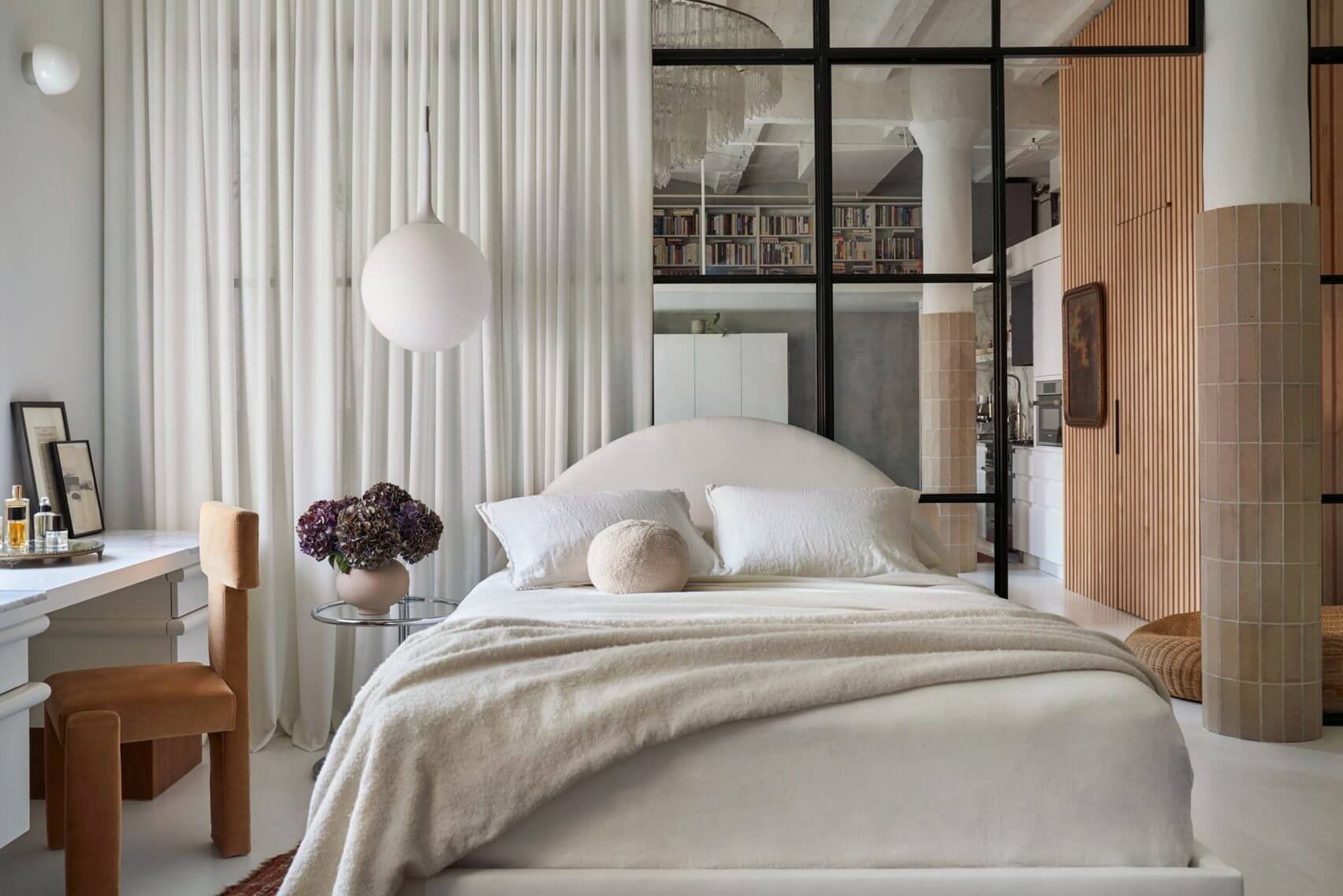

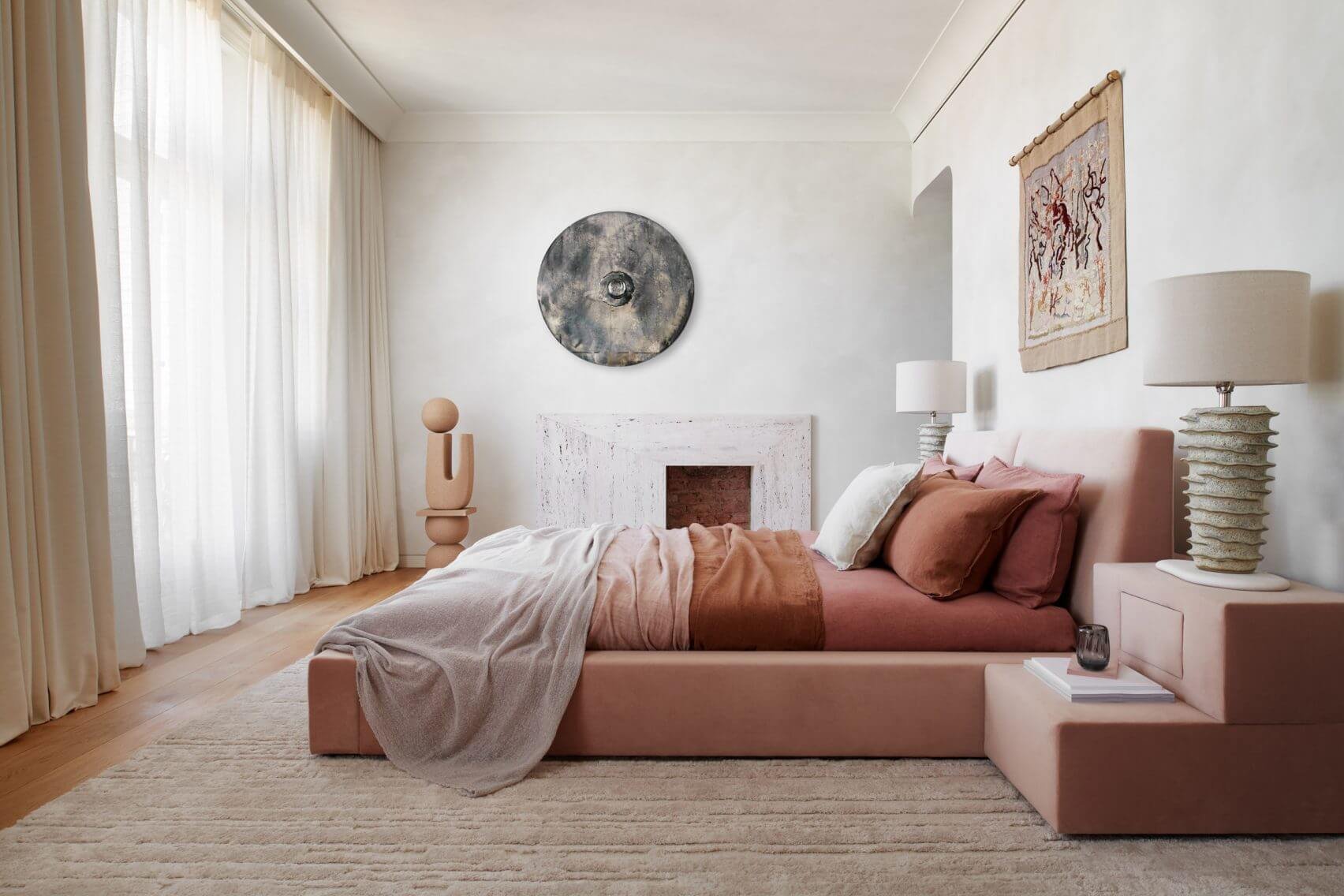

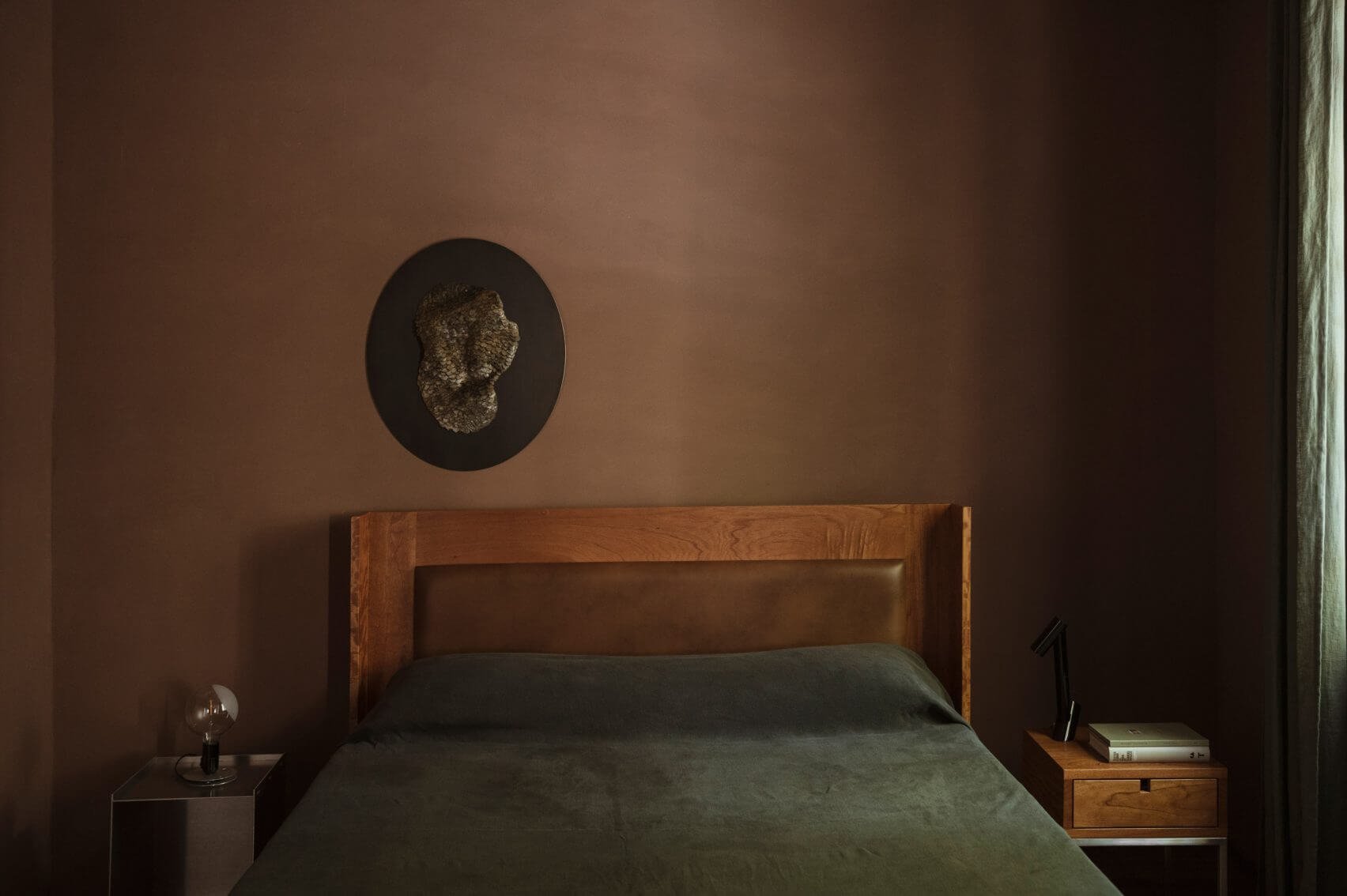



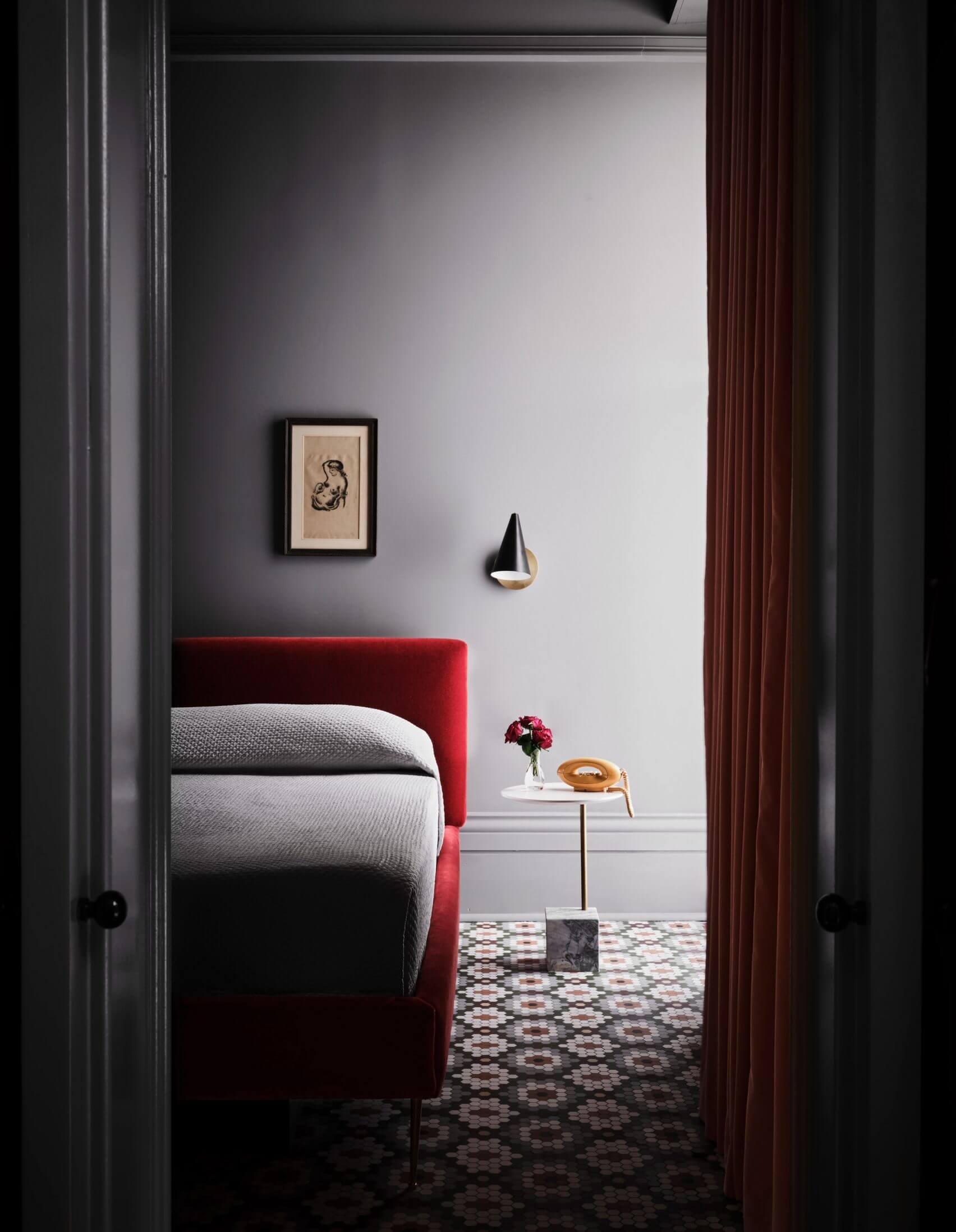









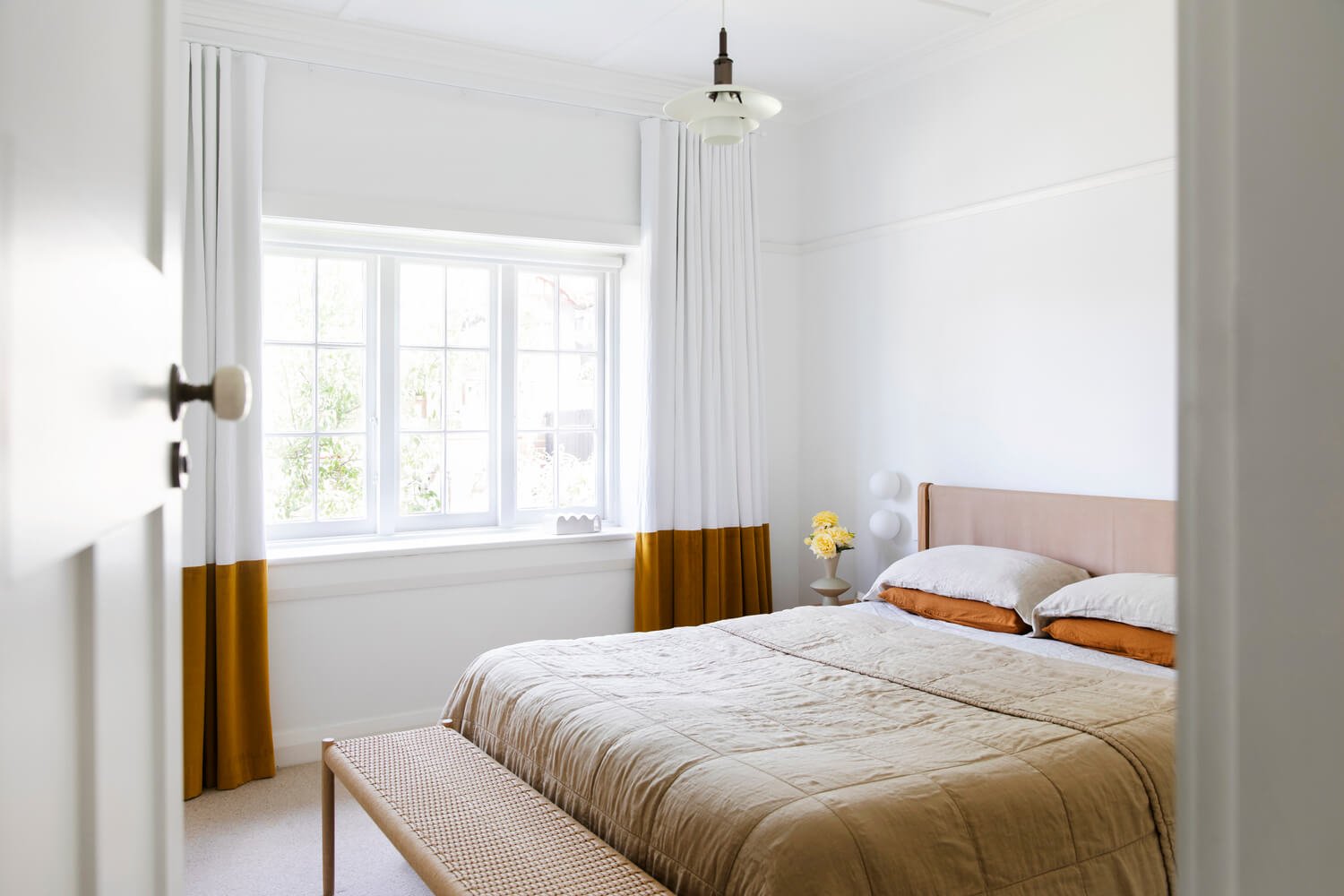
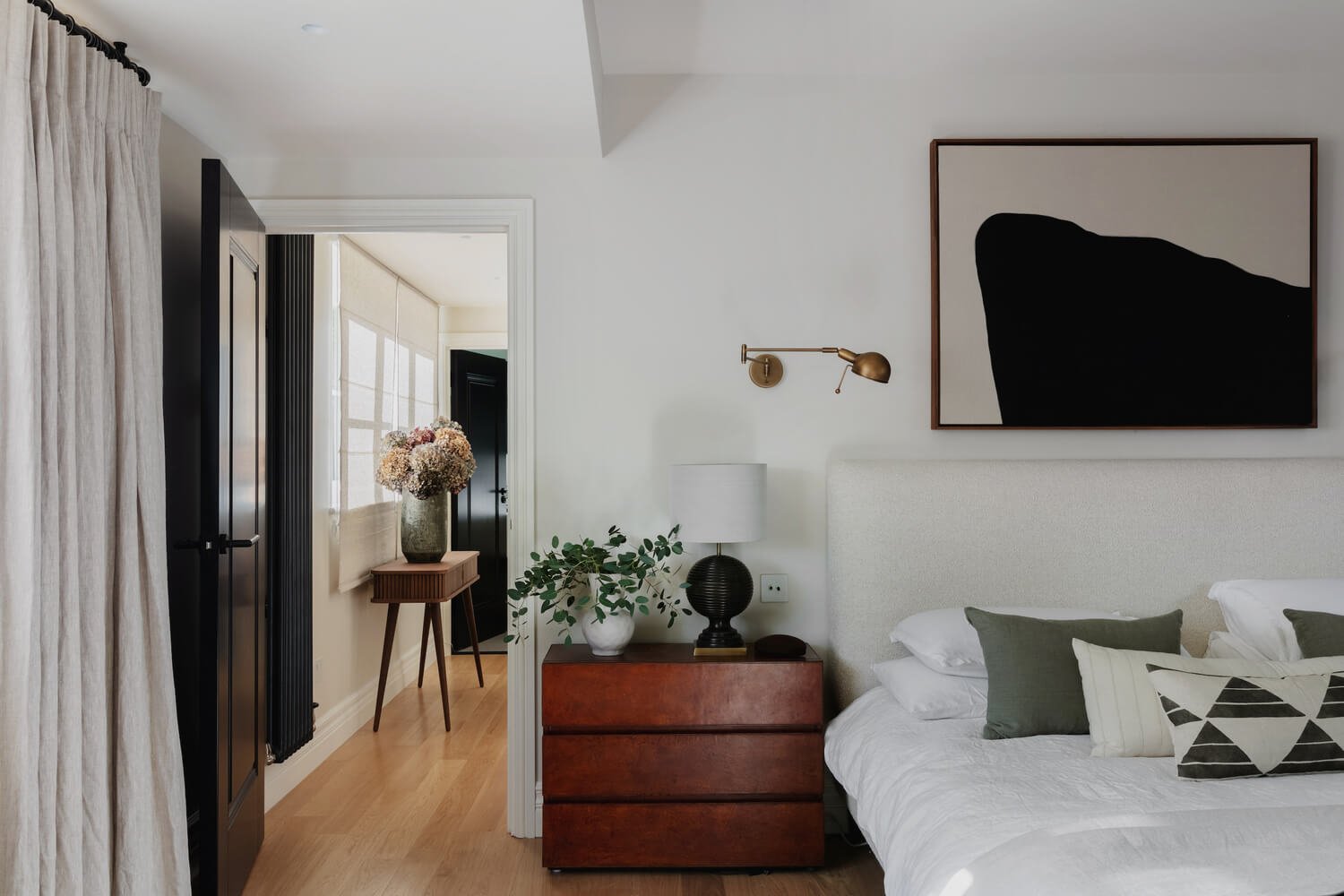
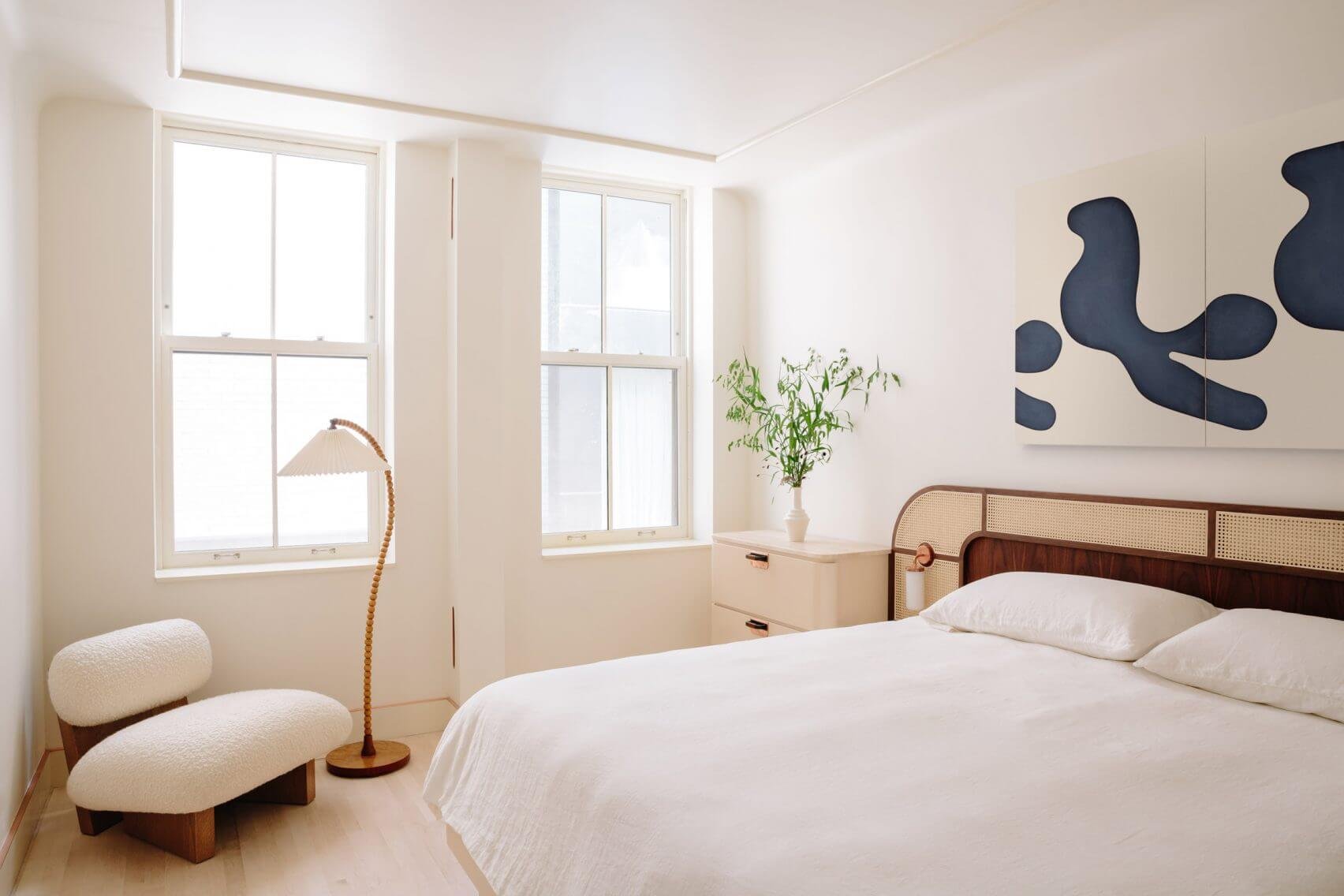


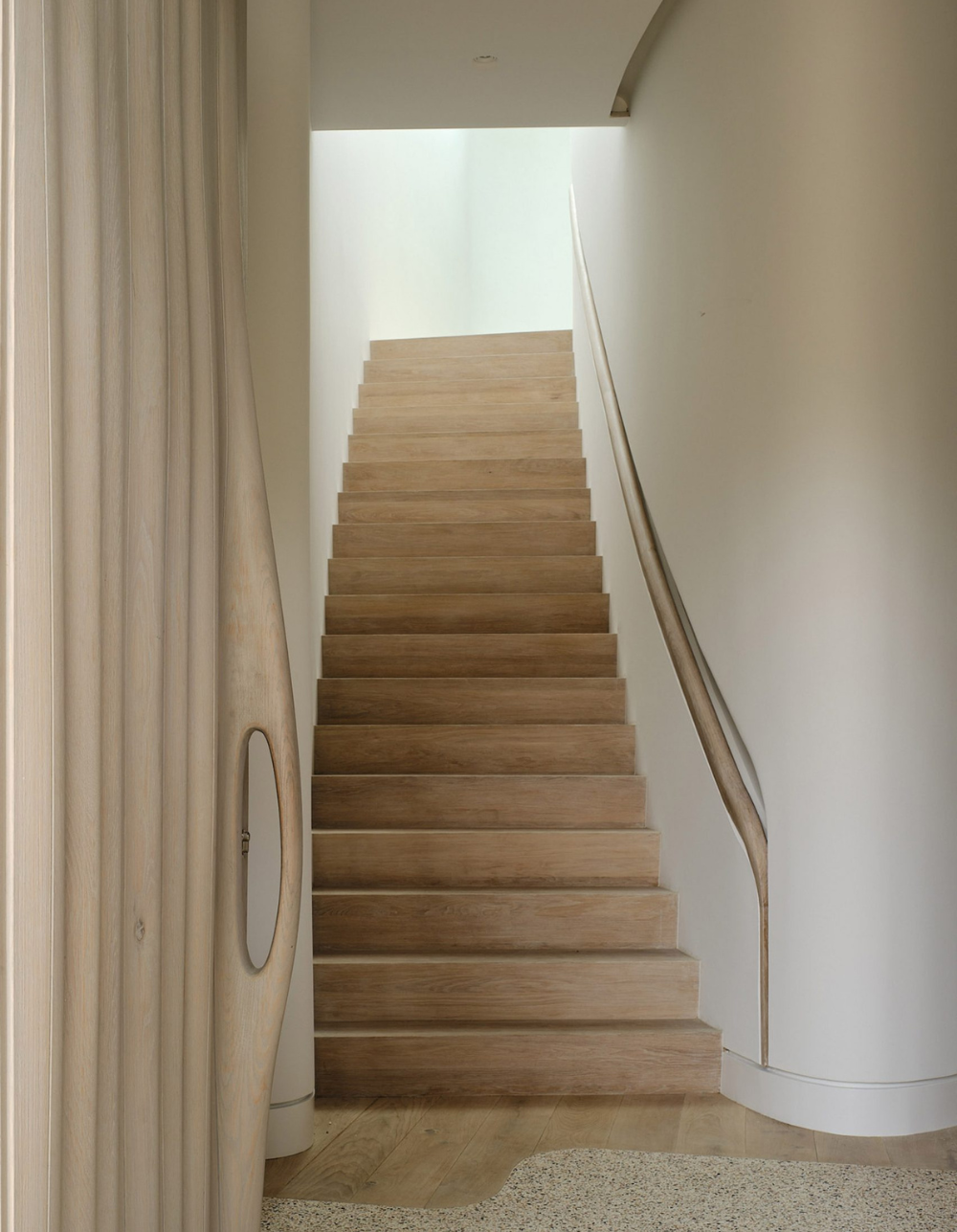
![What Colours Go With Red accents [Walls + Furniture]](https://images.squarespace-cdn.com/content/v1/600310fb2f57da1e2e6c8383/1708081363556-1PV4A30S5C44VM4QR3NH/What_Colours_Go_With_Red_accents_Walls_Furniture.png)




